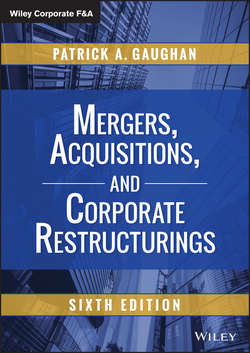Читать книгу Mergers, Acquisitions, and Corporate Restructurings - Gaughan Patrick А. - Страница 9
На сайте Литреса книга снята с продажи.
Part I
Background
Chapter 1
Introduction
Merger Consideration
ОглавлениеMergers may be paid for in several ways. Transactions may use all cash, all securities, or a combination of cash and securities. Securities transactions may use the stock of the acquirer as well as other securities, such as debentures. The stock may be either common stock or preferred stock. They may be registered, meaning they are able to be freely traded on organized exchanges, or they may be restricted, meaning they cannot be offered for public sale, although private transactions among a limited number of buyers, such as institutional investors, are permissible.
If a bidder offers its stock in exchange for the target's shares, this offer may provide for either a fixed or floating exchange ratio. When the exchange ratio is floating, the bidder offers a dollar value of shares as opposed to a specific number of shares. The number of shares that is eventually purchased by the bidder is determined by dividing the value offered by the bidder's average stock price during a prespecified period. This period, called the pricing period, is usually some months after the deal is announced and before the closing of the transaction. The offer could also be defined in terms of a “collar,” which provides for a maximum and minimum number of shares within the floating value agreement.
Stock transactions may offer the seller certain tax benefits that cash transactions do not provide. However, securities transactions require the parties to agree on not only the value of the securities purchased but also the value of those that are used for payment. This may create some uncertainty and may give cash an advantage over securities transactions from the seller's point of view. For large deals, all-cash compensation may mean that the bidder has to incur debt, which may carry with it unwanted, adverse risk consequences.
Merger agreements can have fixed compensation or they can allow for variable payments to the target. It is common in deals between smaller companies, or when a larger company acquires a smaller target, that the payment includes a contingent component. Such payments may include an “earn out” where part of the payments are based upon the performance of the target. The opposite type of variable compensation is one that includes contingent value rights (CVRs). The CVRs guarantee some future value if the acquirer's shares that were given in exchange for the target's shares fall below some agreed-upon threshold. One innovative use of CVRs was Viacom's 1994 offer for QVC, which provided for the sellers to receive the difference between Viacom's stock price at closing and $48. At the time of the offer Viacom's stock price was $40. If a seller believes that its stock is undervalued and will rise in value in the foreseeable future, it may offer a CVR as a way of guaranteeing this. Buyers may possess asymmetric information on the possible future value of their stock that sellers do not have. Chatterjee and Yan found that announcement period returns for offers that include CVR were higher than stock-only bids.5
Sometimes merger agreements include a holdback provision. While alternatives vary, such provisions in the merger agreement provide for some of the compensation to be withheld based upon the occurrence of certain events. For example, the buyer may deposit some of the compensation in an escrow account. If litigation or other specific adverse events occur, the payments may be returned to the buyer. If the events do not occur, the payments are released to the selling shareholders after a specific time period.
5
Sris Chatterjee and An Yan, “Why Do Some Firms Pay with Contingent Value Rights,” Journal of Financial and Quantitative Analysis 43, no. 4 (December 2008): 1001–1036.
